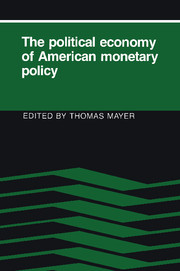Book contents
- Frontmatter
- Contents
- Preface
- List of contributors
- 1 Introduction
- 2 Studying the Fed: toward a broader public-choice perspective
- 3 The Federal Reserve reaction function: a specification search
- 4 Corporate profitability as a determinant of restrictive monetary policy: estimates for the postwar United States
- 5 Federal Reserve behavior since 1980: a financial-market perspective
- 6 The Federal Reserve and its institutional environment: a review
- 7 The political economy of monetary policy
- 8 Political monetary cycles
- 9 Congress and the Fed: why the dog does not bark in the night
- 10 The Federal Reserve as a political power
- 11 Monetary policy and political economy: the Federal Reserve and the Bank of Japan
- 12 A positive analysis of the policy-making process at the Federal Reserve
- 13 A theory of FOMC dissent voting with evidence from the time series
- 14 Explaining FOMC members' votes
- 15 Fed behavior and X-efficiency theory: toward a general framework
- 16 Minimizing regret: cognitive dissonance as an explanation of FOMC behavior
- 17 The discount window
- 18 Leaning against the wind: the behavior of the money stock in recession and recovery, 1953–8
- 19 Bureaucratic self-interest as an obstacle to monetary reform
- Index
3 - The Federal Reserve reaction function: a specification search
Published online by Cambridge University Press: 06 July 2010
- Frontmatter
- Contents
- Preface
- List of contributors
- 1 Introduction
- 2 Studying the Fed: toward a broader public-choice perspective
- 3 The Federal Reserve reaction function: a specification search
- 4 Corporate profitability as a determinant of restrictive monetary policy: estimates for the postwar United States
- 5 Federal Reserve behavior since 1980: a financial-market perspective
- 6 The Federal Reserve and its institutional environment: a review
- 7 The political economy of monetary policy
- 8 Political monetary cycles
- 9 Congress and the Fed: why the dog does not bark in the night
- 10 The Federal Reserve as a political power
- 11 Monetary policy and political economy: the Federal Reserve and the Bank of Japan
- 12 A positive analysis of the policy-making process at the Federal Reserve
- 13 A theory of FOMC dissent voting with evidence from the time series
- 14 Explaining FOMC members' votes
- 15 Fed behavior and X-efficiency theory: toward a general framework
- 16 Minimizing regret: cognitive dissonance as an explanation of FOMC behavior
- 17 The discount window
- 18 Leaning against the wind: the behavior of the money stock in recession and recovery, 1953–8
- 19 Bureaucratic self-interest as an obstacle to monetary reform
- Index
Summary
Twenty-five years ago William Dewald and Harry Johnson (1963) published their path-breaking Federal Reserve reaction function. By regressing an indicator of Fed policy on the Fed's goal variables, such as the unemployment rate and the price index, they tried to replace vague talk about the Fed's response to economic conditions with more rigorous econometric procedures. Not surprisingly, their work gave rise to an extensive research effort. Has that effort been successful? One way to approach that question is to see if Fed reaction functions generally have reached similar conclusions, so that one can say that certain results have been well established. Another way is to ask if the results reached by the use of Fed reaction functions are robust with respect to more or less arbitrary differences in specifications. Unfortunately, as this chapter will show, neither of those conditions has been met.
This is unfortunate, because a reliable Fed reaction function is needed for at least three purposes. One obviously is to predict Fed actions. Another is to evaluate Fed behavior. This is relevant for the debates about monetary rules and the appropriate degree of Fed independence. A third purpose is to aid in estimating the policy multipliers for econometric models. As Stephen Goldfeld and Allan Blinder (1972), among others, have shown, omitting the central bank's reaction function in an econometric model can lead to serious estimation errors.
There exist two types of reaction functions that answer quite distinct questions. One, which may be called an “intentions function,” asks how the Fed wants to change aggregate demand when, say, the unemployment rate changes.
- Type
- Chapter
- Information
- The Political Economy of American Monetary Policy , pp. 27 - 48Publisher: Cambridge University PressPrint publication year: 1990
- 27
- Cited by



